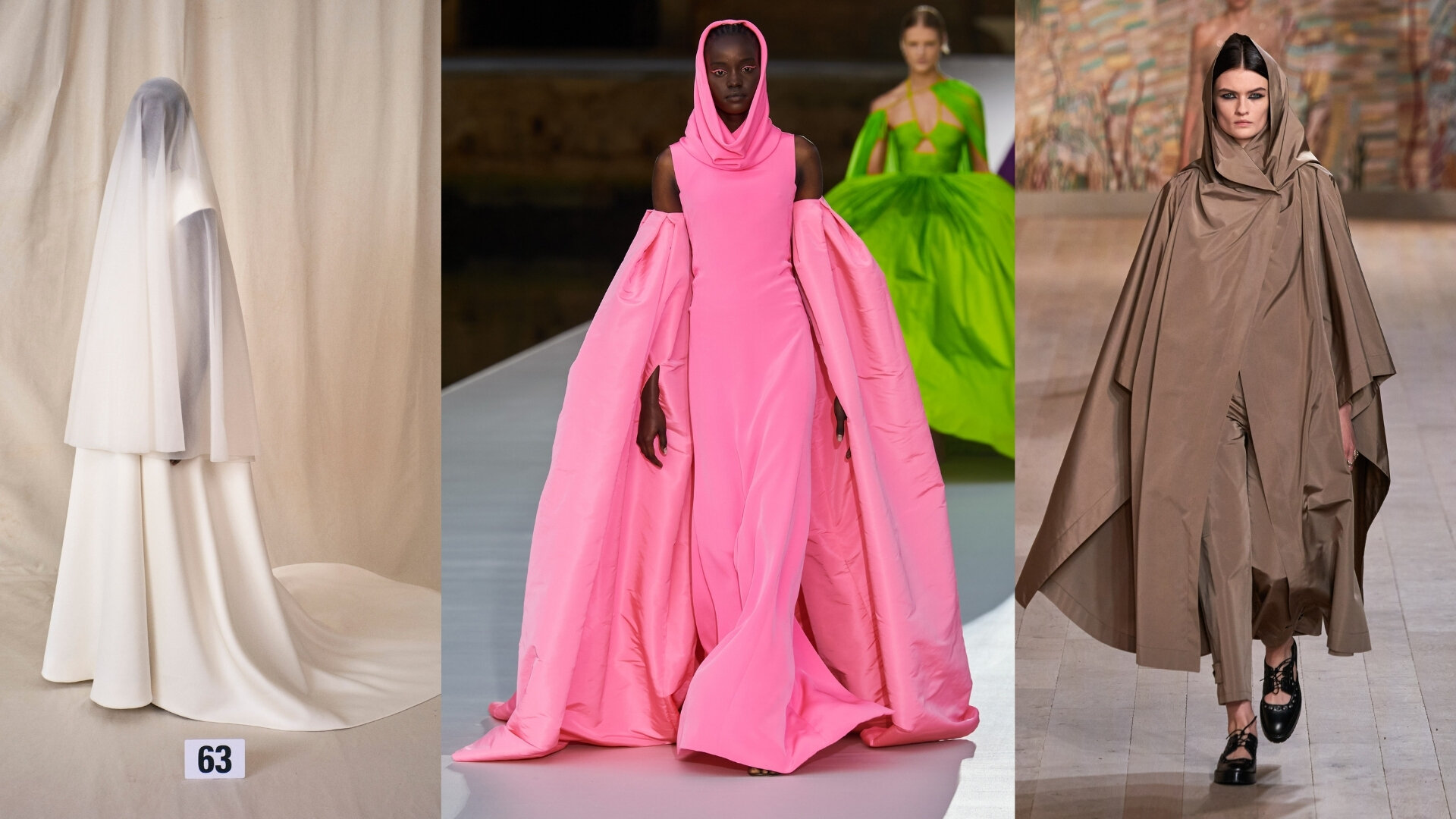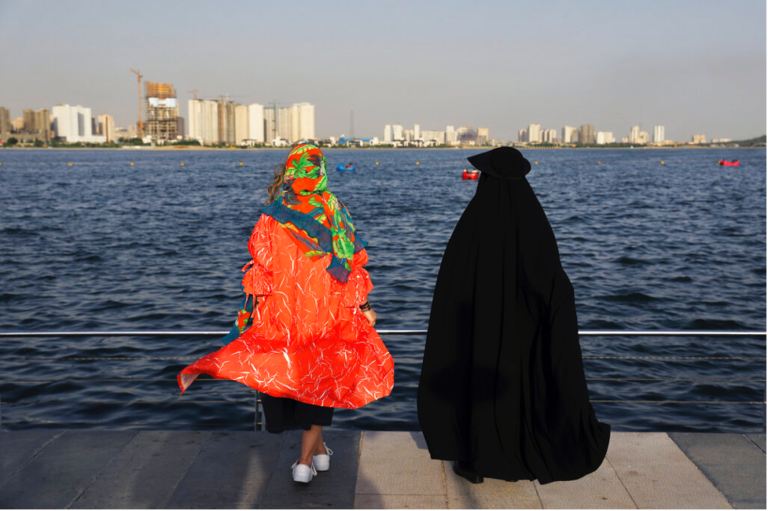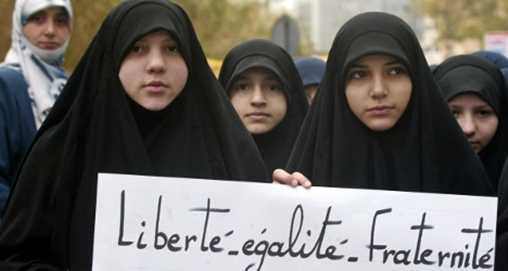
Paris Fashion Week this year was a jungle full of shimmering dresses, massive gowns, 6-inch heels, and an unanticipated trend: headcoverings.
With hooded dresses featured in Balmain’s runway, silk scarves perched on the heads of models for Giambattista Valli, and even bejeweled headpieces on Louis Vuitton’s runway, head coverings were a staple trend in the Parisian fashion world. Even Kim Kardashian’s Balenciaga Met Gala look featured a black fabric covering her head-to-toe, concealing everything but her ponytail.
At first, nothing seems too unusual. Silk scarves used as head coverings have always been a statement in the fashion world, akin to the idea of an Hermes sweetheart. But then you remember: doesn’t France hate headscarves? Or is it only a problem to the French government when Muslim women wear them?
France had its latest Islamophobic controversy earlier this year, when the upper house of the national legislature, the Senate, attempted to pass a law that banned minor Muslim girls from covering their hair in public and any hijabi mothers from chaperoning their children on school trips. While the statute is expected to fail in the National Assembly (the lower chamber), recent discriminatory legislation is one of several attempts by the French government to infringe on the human rights of Muslim women in the past decade. In 2003, hijabs were banned in public schools and in 2010, niqabs (face veils) were banned as well.
Such Islamophobic hypocrisy doesn’t just exist in France, but is a common theme among the European Union. After two German women were suspended from their jobs for wearing a hijab in July of this year, the European Court of Justice ruled that visible symbols of religious beliefs, such as head scarves or yamakas, can be banned in the workplace. The grounds of the ruling was to present a “neutral image” in the workplace, opening up legal grounds for employers to fire employees as a result.
There is no doubt that Islamophobia is a plague in Europe today. So what happens when head coverings become the trendiest accessory on the runways of France’s most global platform: Paris Fashion Week? Who truly has the privilege of wearing a headscarf?
Of all the models at Paris Fashion Week, few models who wore a hijab-styled piece were of color, Muslim, or hijabis of color. One of the only Muslim models at Paris Fashion Week, Moroccan model Imaan Hammam, walked in the Balmain show in a fully hooded dress that made her look like a typical veiled Muslim woman. Only days before at Milan Fashion Week, light-skinned models in the “Fendace” collaboration show between Fendi and Versace wore silk scarves tied around their hair in the same classic fashion as Arab women a few generations ago.
After examining Paris Fashion Week against the backdrop of the EU’s decision and social media culture, it’s clear that headscarves are only acceptable and tolerated by the Western sphere when they sit upon the head of white cis-gendered models. Brown-skinned Muslim women do not have the “privilege” of wearing a hijab and controlling their own bodies.
Fashion is supposed to be an expression of creativity and art, yet the ignorance seen on the runways of Paris Fashion Week against the backdrop of ongoing Islamophobia in Europe is astounding, humiliating, and is a degradation of the struggles Muslim women face today. The overwhelming amount of head coverings on the runway––without any acknowledgment of the current Islamophobic racism –– was a slap in the face for Muslim women around the world, including myself. It’s fashion when a headscarf is on white women, but the moment it is put on a black or brown woman, its oppression and “radical Islam.”
This is not to say that head-coverings should not be seen on the runway; in fact, increasing the diversity of models cast in fashion is needed and encouraged. What is problematic is the double standard and lack of perceptible support or acknowledgement by European designers for the issues hijabi women face. What French designers had the chance to do was use their pieces as a way to stand up against European Islamophobia by showcasing them on actual hijabi models and Muslim models of color. They had the opportunity to deliberately design headscarves into their pieces, with the actual intention of taking a stand against Islamophobia. Instead, they chose to remain silent and culturally appropriate a sensitive religious symbol. As white designers tend to do.
With a history of racism, elitism, and exclusiveness, couture houses remain severely out of touch with BIPOC and diversity issues. After dozens of instances where designers such as Balenciaga or Christian Dior have been caught stealing from designers of color or have portrayed racist values in their work, this repeated instance of cultural appropriation is not surprising.
Moreover, French history––the prided foundation that allows French fashion houses to exist today––has a thirteen hundred year past of colonial invasion and racist crimes against mainly Muslim-majority countries such as Morrocoo, Algeria, Egypt, Tunisia, and Syria. Recent legal actions have been acutely directed towards women who choose headcoverings. Yet, the sudden “trendiness” of headscarves (only on white women though) depicts the physical ramifications French Muslim women face, fighting to survive every day and prove that they are “French” enough to live in its so-called “Republic”. They are forced to choose between working to build a career for themselves or be who they are. Designers who showcased head scarves without acknowledging the threat French Muslim women face every day are mocking the identitiy of Muslim women globally.
Fashion is a dominant power in shaping the world. It is a frontier and transformational method of defiance that can speak to volumes against racism and xenophobia. As Amani, activist and founder of Muslim Girl, writes for The Cut, “[Paris Fashion Week is] reminiscent of the infamous 2016 burkini ban on Nice beaches that birthed the shameful viral photo of French police forcing a Muslim woman to strip; in solidarity, scuba divers showed up to the beach wearing wetsuits to underscore the double standard.”
French fashion houses could have been the scuba divers. Instead, they became the police; while their white models wore head scarfs on the runway––synonymous with how scuba divers were allowed to wear their bathing suits––they continue to stand by the hypocrisy and allowed their government to violate the human rights of Muslim women.
Islamophobia is rampant. Meanwhile, fashion houses continue to profit off of Muslim women and their sensitive religious symbols. As head scarves start trending their way to the top of the fashion food chain and the new consequential sense of “empowerment” found in conservative clothing begins to spread in the Western world, the silence for those on the other side of the privilege line is deafening.



